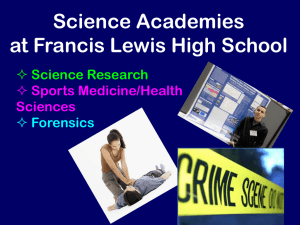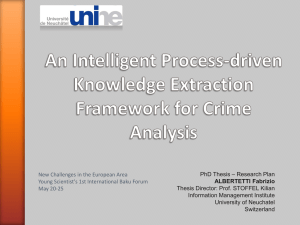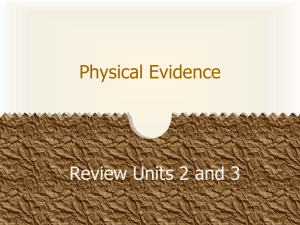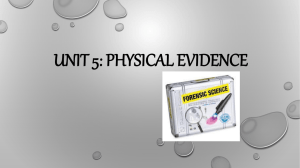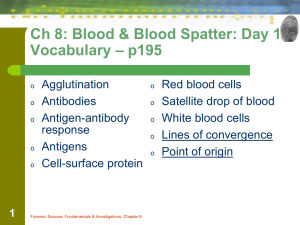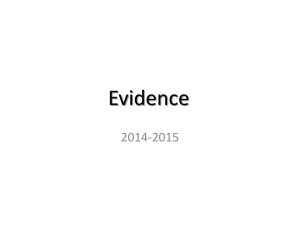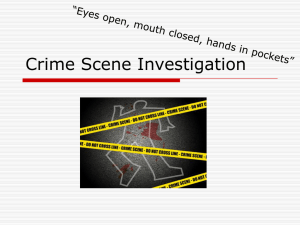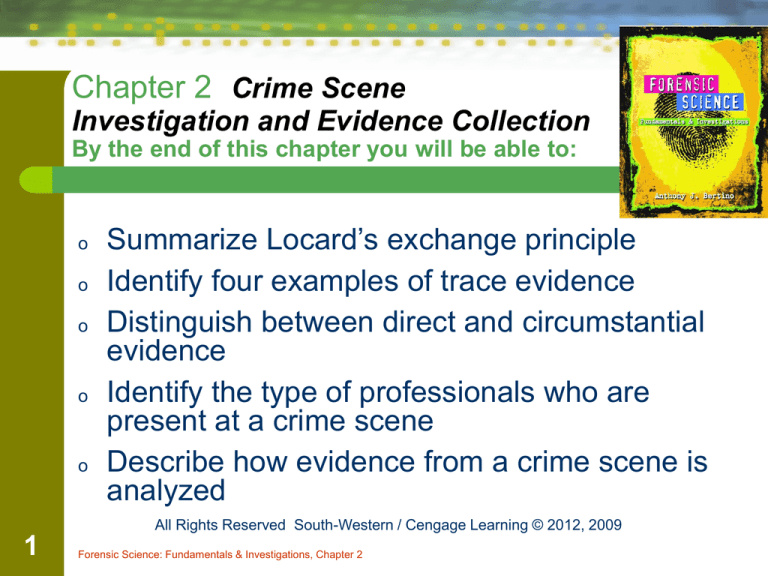
Chapter 2 Crime Scene
Investigation and Evidence Collection
By the end of this chapter you will be able to:
o
o
o
o
o
Summarize Locard’s exchange principle
Identify four examples of trace evidence
Distinguish between direct and circumstantial
evidence
Identify the type of professionals who are
present at a crime scene
Describe how evidence from a crime scene is
analyzed
All Rights Reserved South-Western / Cengage Learning © 2012, 2009
1
Forensic Science: Fundamentals & Investigations, Chapter 2
Chapter 2 Crime Scene
Investigation and Evidence Collection
By the end of this chapter you will be able to:
o
o
o
o
2
Summarize the three steps of a crime scene
investigation
Explain the importance of securing the crime
scene
Identify the methods by which a crime scene
is documented
Demonstrate proper technique in collecting
and packaging trace evidence
Forensic Science: Fundamentals & Investigations, Chapter 2
Principle of Exchange
Established by Dr. Edmond Locard,
the principle states:
o
When a person comes in contact with an
object or another person, a cross-transfer of
physical material can occur
o
Study of the material can determine the
nature and duration of the transfer
3
Forensic Science: Fundamentals & Investigations, Chapter 2
Types of Evidence
Direct evidence
Testimony by a
witness about what
that witness saw,
heard, or did
4
Forensic Science: Fundamentals & Investigations, Chapter 2
Types of Evidence
Circumstantial evidence
•
also called Indirect
•
trace evidence
Physical evidence
•
e.g., fingerprints
Biological evidence
•
5
Forensic Science: Fundamentals & Investigations, Chapter 2
e.g., blood or hairs
Types of Evidence
Explain why this would be or
would not be trace evidence
6
Forensic Science: Fundamentals & Investigations, Chapter 2
The Crime Scene
Investigation Team
Who is at the crime scene?
o
o
o
o
o
o
7
Police and
District attorney (possibly)
Crime scene investigators
Medical examiners
Detectives
Specialists
Forensic Science: Fundamentals & Investigations, Chapter 2
The Seven S’s of Crime Scene
Investigation
1.
2.
3.
4.
5.
6.
7.
8
Secure the scene
Separate the witnesses
Scan the scene
Seeing the scene
Sketch the scene
Search for evidence
Secure the collected evidence
Forensic Science: Fundamentals & Investigations, Chapter 2
Crime-Scene Sketch Form
9
Forensic Science: Fundamentals & Investigations, Chapter 2
Crime-Scene Search Patterns
10
Forensic Science: Fundamentals & Investigations, Chapter 2
Packaging the evidence
Crease a clean paper and
place evidence in the X
position
2. Fold in the left and right sides,
and then fold in the top and
bottom
3. Put the bindle into a plastic or
paper evidence bag affixing a
seal over the opening
4. Write your name on the seal
1.
11
Forensic Science: Fundamentals & Investigations, Chapter 2
Evidence ID Forms
12
Forensic Science: Fundamentals & Investigations, Chapter 2
Chain of Custody
Maintaining a chain of custody log is essential to
present credible evidence in court
13
Forensic Science: Fundamentals & Investigations, Chapter 2
Chain of Custody (cont’d.)
1. Bag the evidence
Add identification
Seal it
Sign it across the sealed edge
2. Sign over to a lab technician
Open bag on non-sealed edge
3. Return items to the evidence bag
Seal evidence bag in another
bag
Sign the evidence log
14
Forensic Science: Fundamentals & Investigations, Chapter 2
Analyze the Evidence
o
o
15
Facts result from collected evidence
processed by the forensic lab
Lead detective aims to see how facts fit into
the crime scenario
Forensic Science: Fundamentals & Investigations, Chapter 2
Analyze the Evidence
Lab results can:
o Show reliability of witness accounts
o Establish the identity of suspects or victims
o Show suspects to be innocent or link them
with a scene or victim
16
Forensic Science: Fundamentals & Investigations, Chapter 2
Crime Scene Reconstruction
Crime scene reconstruction involves:
o Forming a hypothesis of the sequence of
events
o From before the crime was committed
through its commission
17
Forensic Science: Fundamentals & Investigations, Chapter 2
Staged Crime Scenes
When lab results don’t match up with the
testimony of witnesses
Common examples:
o
o
o
18
Staging a fire—to cover bankruptcy
Staging a suicide—to cover a murder
Staging a burglary—to collect insurance
money
Forensic Science: Fundamentals & Investigations, Chapter 2
Staged Crime Scenes
Was the crime scene staged?
Consider:
o
o
o
o
19
Does the type of wound match the weapon?
Could the wound be easily self-inflicted?
What were the mood and actions of the victim
before the event?
What were the mood and actions of the suspect
before the event?
Forensic Science: Fundamentals & Investigations, Chapter 2
. . . . . . . . . . . . . . Summary . . . .
o
o
o
20
Locard’s exchange principle:
• Contact between people and objects can
transfer material that can determine the nature
and duration of the transfer
Evidence can be direct or indirect
• Physical or biological traces
A crime scene investigation team consists of
police, detectives, crime scene investigators,
medical investigators, and specialists.
Forensic Science: Fundamentals & Investigations, Chapter 2
. . . . . . . . . . . . . . . . . Summary
o
o
o
o
o
21
Investigations consist of recognizing, documenting,
and collecting evidence.
First responding officers identify the extent of the
crime scene, secure it, and segregate witnesses.
Crime scene investigators document the crime
scene.
Evidence is collected, packaged, and labeled.
The evidence is analyzed and interpreted to fit the
crime scenario.
Forensic Science: Fundamentals & Investigations, Chapter 2

